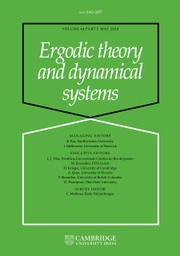No CrossRef data available.
Article contents
Hausdorff dimension of multidimensional multiplicative subshifts
Published online by Cambridge University Press: 19 July 2023
Abstract
The purpose of this study is two-fold. First, the Hausdorff dimension formula of the multidimensional multiplicative subshift (MMS) in  $\mathbb {N}^d$ is presented. This extends the earlier work of Kenyon et al [Hausdorff dimension for fractals invariant under multiplicative integers. Ergod. Th. & Dynam. Sys. 32(5) (2012), 1567–1584] from
$\mathbb {N}^d$ is presented. This extends the earlier work of Kenyon et al [Hausdorff dimension for fractals invariant under multiplicative integers. Ergod. Th. & Dynam. Sys. 32(5) (2012), 1567–1584] from  $\mathbb {N}$ to
$\mathbb {N}$ to  $\mathbb {N}^d$. In addition, the preceding work of the Minkowski dimension of the MMS in
$\mathbb {N}^d$. In addition, the preceding work of the Minkowski dimension of the MMS in  $\mathbb {N}^d$ is applied to show that their Hausdorff dimension is strictly less than the Minkowski dimension. Second, the same technique allows us to investigate the multifractal analysis of multiple ergodic average in
$\mathbb {N}^d$ is applied to show that their Hausdorff dimension is strictly less than the Minkowski dimension. Second, the same technique allows us to investigate the multifractal analysis of multiple ergodic average in  $\mathbb {N}^d$. Precisely, we extend the result of Fan et al, [Multifractal analysis of some multiple ergodic averages. Adv. Math. 295 (2016), 271–333] of the multifractal analysis of multiple ergodic average from
$\mathbb {N}^d$. Precisely, we extend the result of Fan et al, [Multifractal analysis of some multiple ergodic averages. Adv. Math. 295 (2016), 271–333] of the multifractal analysis of multiple ergodic average from  $\mathbb {N}$ to
$\mathbb {N}$ to  $\mathbb {N}^d$.
$\mathbb {N}^d$.
MSC classification
- Type
- Original Article
- Information
- Copyright
- © The Author(s), 2023. Published by Cambridge University Press



